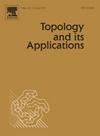子树距离,紧密跨度和多样性
IF 0.5
4区 数学
Q3 MATHEMATICS
引用次数: 0
摘要
我们描述当集合x中元素之间的距离d(x,y)有子树表示,实树T和T的子树集合{Sx}x∈x,使得d(x,y)等于T中从Sx中的一点到Sy中的一点对所有x,y∈x的最短路径的长度。Hirai(2006)首先在有限的X上建立了这个特征,使用了一个为距离空间定义的紧跨度构造,度量空间没有三角形不等式。为了将Hirai的结果推广到有限X之外,我们建立了一般距离空间的紧跨度理论的基本结果,包括距离空间的紧跨度是超凸的惊人观察。我们应用这些结果得到了当一个分集——一个度量空间的泛化,它给X的所有有限子集赋值,而不仅仅是给对赋值——具有树状的紧张成空间时的第一个特征。本文章由计算机程序翻译,如有差异,请以英文原文为准。
Subtree distances, tight spans and diversities
We characterize when a set of distances between elements in a set X have a subtree representation, a real tree T and a collection of subtrees of T such that equals the length of the shortest path in T from a point in to a point in for all . The characterization was first established for finite X by Hirai (2006) using a tight span construction defined for distance spaces, metric spaces without the triangle inequality. To extend Hirai's result beyond finite X we establish fundamental results of tight span theory for general distance spaces, including the surprising observation that the tight span of a distance space is hyperconvex. We apply the results to obtain the first characterization of when a diversity – a generalization of a metric space which assigns values to all finite subsets of X, not just to pairs – has a tight span which is tree-like.
求助全文
通过发布文献求助,成功后即可免费获取论文全文。
去求助
来源期刊
CiteScore
1.20
自引率
33.30%
发文量
251
审稿时长
6 months
期刊介绍:
Topology and its Applications is primarily concerned with publishing original research papers of moderate length. However, a limited number of carefully selected survey or expository papers are also included. The mathematical focus of the journal is that suggested by the title: Research in Topology. It is felt that it is inadvisable to attempt a definitive description of topology as understood for this journal. Certainly the subject includes the algebraic, general, geometric, and set-theoretic facets of topology as well as areas of interactions between topology and other mathematical disciplines, e.g. topological algebra, topological dynamics, functional analysis, category theory. Since the roles of various aspects of topology continue to change, the non-specific delineation of topics serves to reflect the current state of research in topology.
At regular intervals, the journal publishes a section entitled Open Problems in Topology, edited by J. van Mill and G.M. Reed. This is a status report on the 1100 problems listed in the book of the same name published by North-Holland in 1990, edited by van Mill and Reed.

 求助内容:
求助内容: 应助结果提醒方式:
应助结果提醒方式:


